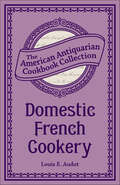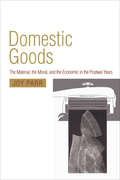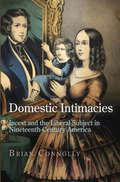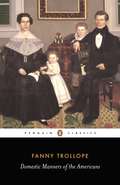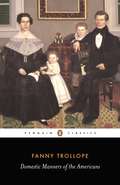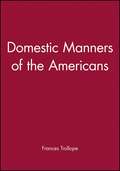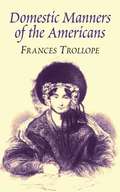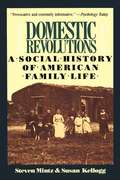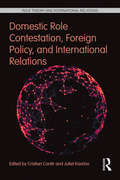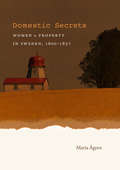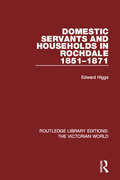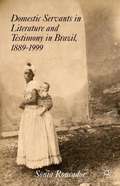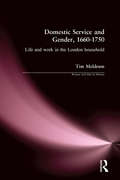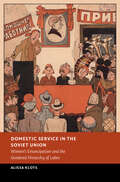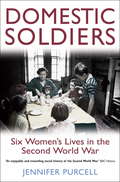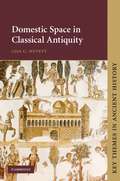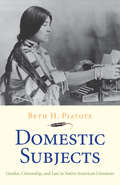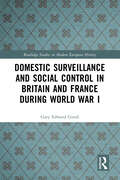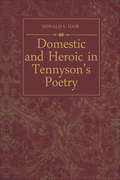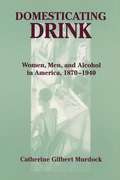- Table View
- List View
Domestic Enemies: Servants and Their Masters in Old Regime France
by Cissie FairchildsOriginally published in 1983. This book cuts across the class boundaries of traditionally separate fields of social history. It investigates the social origins of servants, their incomes, their marriage and family patterns, their career patterns, their possibilities for social mobility, their political activities, and their criminality. But it also investigates the history of the family and domestic life in France in the sixteenth, seventeenth, and eighteenth centuries, for servants were, at least until the rise of the affectionate nuclear family in the middle of the eighteenth century, considered part of the families of those they served. Finally, this book is also an essay on the history of social relationships in the ancien régime, not only those between masters and servants but also the broader relationships between the ruling elite and the lower classes. The introduction gives basic facts about the composition of households during the Old Regime and explores the attitudes and assumptions that underlay the employment of servants. It also shows how both these attitudes and the households themselves changed dramatically in the last decades before the French Revolution. Part 1 is devoted to the servants themselves. One chapter deals with their lives within their employers' households: their work, their living conditions, their socializing and leisure-time activities. A second examines their private lives: their social origins, marriage and family patterns, their moneymaking and their criminality. And a third explores their relationships with and attitudes toward their masters. In part 2, the focus shifts to an examination of master–servant relationships from the masters' point of view. The first chapter deals with master–servant relationships in general by discussing the factors that determined how employers treated their domestics. The second and third chapters explore two special relationships: masters' sexual relationships with their servants and their relationships with the servants who cared for them in childhood. The epilogue traces the impact of the French Revolution on domestic service and sketches some of the changes in the household that were to come in the nineteenth century.
Domestic Enemies: The Founding Fathers' Fight Against the Left
by Daniel GreenfieldThe secret history of the American Left.The Left is America&’s oldest enemy. It was here long before the 1960s, calling for the execution of George Washington, plotting to stop the ratification of the Constitution, and collaborating with foreign enemies. Stolen elections, fake news, race riots, globalism, and socialism aren&’t new problems; Americans faced them from the very beginning. Domestic Enemies reveals the true origins of the Democratic Party and its radicals, who—even two centuries ago—were calling for the redistribution of wealth, the end of marriage, and the use of schools for political indoctrination. From political battles to street fights, Domestic Enemies takes you into the heart of a century of forgotten struggles between America&’s greatest heroes—such as Washington, Hamilton, Davy Crockett, and Abraham Lincoln—and radical villains like Aaron Burr. This is a 1619 Project for the American Left: a history of the Democrats as you&’ve never heard it before, told through the political debates, naval battles, race riots, scandals, secret societies, and domestic terrorism that made the Left what it is today. Learn how the Founding Fathers defeated the Left before, and how we can beat it again.
Domestic French Cookery
by Louis AudotPublished in 1832 in Philadelphia, Domestic French Cookery by well-known French writer Louis-Eustache Audot was translated and adapted for an American audience by Eliza Leslie, one of the most popular and prolific American cookbook authors of the 19th century. This classic French cookbook was originally published in Paris in 1818 and has had 87 editions—the American adaptation was also very successful with over 6 editions printed in 23 years. For the American version of Domestic French Cookery, Leslie took great pains to adapt the work for American tools, techniques, and available food. As stated in her preface, Leslie notes that she &“aimed at making a book of practical utility to all those who may have a desire to introduce occasionally at their tables good specimens of the French culinary art.&” Furthermore, Leslie deemed food items such as sheep&’s tails and calves&’ ears as below her American audience&’s tastes and instead focused on including &“respectable&” recipes such as Maccaroni Soup, French Coffee, Fine Lemonade, Convenient Lemonade, French Cucumber Pickles, and Chocolate Drops. This edition of Domestic French Cookery was reproduced by permission from the volume in the collection of the American Antiquarian Society, Worcester, Massachusetts. Founded in 1812 by Isaiah Thomas, a Revolutionary War patriot and successful printer and publisher, the society is a research library documenting the lives of Americans from the colonial era through 1876. The society collects, preserves, and makes available as complete a record as possible of the printed materials from the early American experience. The cookbook collection comprises approximately 1,100 volumes.
Domestic Goods
by Joy ParrVisions of life in the 1950s often spring from the United States: supermarkets, freeways, huge gleaming cars, bright new appliances, automated households. Historian Joy Parr looks beyond the generalizations about the indulgence of this era to find a specifically Canadian consumer culture. Focusing on the records left by consumer groups and manufacturers, and relying on interviews and letters from many Canadian women who had set up household in the decade after the war, she reveals exactly how and why Canadian homemakers distinguished themselves from the consumer frenzy of their southern neighbours. Domestic Goods focuses primarily on the design, production, promotion, and consumption of furniture and appliances. For Parr, such a focus demands an analysis of the intertwining of the political, economic, and aesthetic. Parr examines how the shortage of appliances in the early postwar years was a direct result of government reconstruction policy, and how the international style of 'high modernism' reflected the postwar dream of free trade. But while manufacturers devised new plans for the consumer, depression-era frugality and a conscious setting of priorities within the family led potential customers to evade and rework what was offered them, eventually influencing the kinds of goods created. This book addresses questions such as, who designed furniture and appliances, and how were these designs arrived at? What was the role of consumer groups in influencing manufacturers and government policy? Why did women prefer their old wringer washers for over a decade after the automatic washer was brought in? In finding the answers the author celebrates and ultimately suggests reclaiming a particularly Canadian way of consuming.
Domestic Intimacies
by Brian ConnollyAlthough it is commonly thought that incest has been taboo throughout history, nineteenth-century Americans evinced a great cultural anxiety that the prohibition was failing. Theologians debated the meaning and limits of biblical proscription, while jurists abandoned such injunctions and invented a new prohibition organized around the nuclear family. Novelists crafted fictional tales of accidental incest resulting from the severed ties between public and private life, while antislavery writers lamented the ramifications of breaking apart enslaved families. Phrenologists and physiologists established reproduction as the primary motivation of the incest prohibition while naturalizing the incestuous eroticism of sentimental family affection. Ethnographers imagined incest as the norm in so-called primitive societies in contrast to modern civilization. In the absence of clear biological or religious limitations, the young republic developed numerous, varied, and contradictory incest prohibitions.Domestic Intimacies offers a wide-ranging, critical history of incest and its various prohibitions as they were defined throughout the nineteenth century. Historian Brian Connolly argues that at the center of these convergent anxieties and debates lay the idea of the liberal subject: an autonomous individual who acted on his own desires yet was tempered by reason, who enjoyed a life in public yet was expected to find his greatest satisfaction in family and home. Always lurking was the need to exercise personal freedom with restraint; indeed, the valorization of the affectionate family was rooted in its capacity to act as a bulwark against licentiousness. However it was defined, incest was thus not only perceived as a threat to social stability; it also functioned to regulate social relations--within families and between classes as well as among women and men, slaves and free citizens, strangers and friends. Domestic Intimacies overturns conventional histories of American liberalism by placing the fear of incest at the heart of nineteenth-century conflicts over public life and privacy, kinship and individualism, social contracts and personal freedom.
Domestic Manners of the Americans
by Fanny TrollopeWhen Fanny Trollope set sail for America in 1827 with hopes of joining a Utopian community of emancipated slaves, she took with her three of her children and a young French artist, leaving behind her son Anthony, growing debts and a husband going slowly mad from mercury poisoning. But what followed was a tragicomedy of illness, scandal and failed business ventures. Nevertheless, on her return to England Fanny turned her misfortunes into a remarkable book. A masterpiece of nineteenth-century travel-writing, Domestic Manners of the Americans is a vivid and hugely witty satirical account of a nation and was a sensation on both sides of the Atlantic. Edited and with notes and introduction by Pamela Melville-Singleton.
Domestic Manners of the Americans
by Fanny TrollopeWhen Fanny Trollope set sail for America in 1827 with hopes of joining a Utopian community of emancipated slaves, she took with her three of her children and a young French artist, leaving behind her son Anthony, growing debts and a husband going slowly mad from mercury poisoning. But what followed was a tragicomedy of illness, scandal and failed business ventures. Nevertheless, on her return to England Fanny turned her misfortunes into a remarkable book. A masterpiece of nineteenth-century travel-writing, Domestic Manners of the Americans is a vivid and hugely witty satirical account of a nation and was a sensation on both sides of the Atlantic.
Domestic Manners of the Americans
by John Lauritz Larson Frances TrollopeRichly informative on American manners and morals in the early ninteenth century, this famous travel account also reveals much about the contrast between British and American culture.
Domestic Manners of the Americans
by Frances TrollopeFrances Trollope, mother of the great Victorian novelist Anthony Trollope, wrote more than 40 books in her lifetime, including provocative, landmark novels dealing with important social issues. Today, however, she's best known for her witty, entertaining, and controversial account of American life and culture — Domestic Manners of the Americans. First published in 1832, this travel classic presents a lively portrait of early nineteenth-century America as observed by a woman of rare intelligence and keen perception.Mrs. Trollope left no stone unturned, commenting on American dress, food, speech, politics, manners, customs, the landscape, architecture, and more — often critically, occasionally admiringly, but always with considerable insight and fine literary flair. Of her, Mark Twain observed: "Of all the tourists I like Dam Trollope best, she found a 'civilization' here which you, reader, could not have endured; and which you would not have regarded as civilization at all. Mrs. Trollope spoke of this civilization in plain terms — plain and unsugared, but honest and without malice, and without hate. "An immediate bestseller on its first publication, the book remains one of the most popular of all American travel accounts.
Domestic Politics, International Bargaining and China's Territorial Disputes (Politics In Asia Ser.)
by Chien-peng ChungThis is a groundbreaking analysis of China's territorial disputes, exploring the successes and failures of negotiations that have taken place between its three neighbours, namely India, Japan and Russia. By using Roberts Putnam's two level game framework, Chung relates the outcome of these disputes to the actions of domestic nationalist groups who
Domestic Revolutions: A Social History of American Family Life
by Steven MintzThe American family has undergone a series of transformations from its socially sanctified role as the center of society to today's private, independent unit. The authors explain just how the family has adapted and endured these changes.
Domestic Role Contestation, Foreign Policy, and International Relations (Role Theory and International Relations)
by Juliet Kaarbo Cristian CantirDespite the increase in the number of studies in international relations using concepts from a role theory perspective, scholarship continues to assume that a state’s own expectations of what role it should play on the world stage is shared among domestic political actors. Cristian Cantir and Juliet Kaarbo have gathered a leading team of internationally distinguished international relations scholars to draw on decades of research in foreign policy analysis to explore points of internal contestation of national role conceptions (NRCs) and the effects and outcomes of contestation between domestic political actors. Nine detailed comparative case studies have been selected for the purpose of theoretical exploration, with an eye to illustrating the relevance of role contestation in a diversity of settings, including variation in period, geographic area, unit of analysis, and aspects of the domestic political process. This edited book includes a number of pioneering insights into how the domestic political process can have a crucial effect on how a country behaves at the global level.
Domestic Secrets: Women and Property in Sweden, 1600-1857
by Maria AgrenBetween the seventeenth and nineteenth centuries, women's role in the Swedish economy was renegotiated and reconceptualized. Maria Agren chronicles changes in married women's property rights, revealing the story of Swedish women's property as not just a simple narrative of the erosion of legal rights, but a more complex tale of unintended consequences. A public sphere of influence--including the wife's family and the local community--held sway over spousal property rights throughout most of the seventeenth century, Agren argues. Around 1700, a campaign to codify spousal property rights as anarcanum domesticum, or domestic secret, aimed to increase efficiency in legal decision making. New regulatory changes indeed reduced familial interference, but they also made families less likely to give land to women. The advent of the print medium ushered property issues back into the public sphere, this time on a national scale, Agren explains. Mass politicization increased sympathy for women, and public debate popularized more progressive ideas about the economic contributions of women to marriage, leading to mid-nineteenth-century legal reforms that were more favorable to women. Agren's work enhances our understanding of how societies have conceived of women's contributions to the fundamental institutions of marriage and the family, using as an example a country with far-reaching influence during and after the Enlightenment.
Domestic Servants and Households in Rochdale: 1851-1871 (Routledge Library Editions: The Victorian World #25)
by Edward HiggsFirst published in 1986. At any one time in late nineteenth-century England and Wales over one million men and women were described as domestic servants in the occupational category after agricultural work. This title explores several aspects of domestic service in the area of Rochdale, and the servant population is examined to discover who entered the service, at what age, and from what background they came. This title will be of interest to students of history.
Domestic Servants in Literature and Testimony in Brazil, 1889–1999
by Sônia RoncadorDrawing from a variety of historical sources, theory, and fictional and non-fictional production, this book addresses the cultural imaginary of domestic servants in modern Brazil and demonstrates maids' symbolic centrality to shifting notions of servitude, subordination, femininity, and domesticity.
Domestic Service and Gender, 1660-1750: Life and work in the London household (Women And Men In History)
by Tim MeldrumIn this exciting new study Tim Meldrum explores the "real lives" of domestic servants. From close examination of court records and other documentary evidence, he has reconstructed the lives of ordinary domestic servants in London. A revealing account of life below the stairs, the gendered nature of domestic service, how different members of the household interacted with one another, it makes a valuable contribution to the "separate spheres" debate.
Domestic Service in the Soviet Union: Women's Emancipation and the Gendered Hierarchy of Labor (New Studies in European History)
by Alissa KlotsThis innovative study is the first to explore the evolution of domestic service in the Soviet Union, set against the background of changing discourses on women, labour, and socialist living. Even though domestic service conflicted with the Bolsheviks' egalitarian message, the regime embraced paid domestic labor as a temporary solution to the problem of housework. Analyzing sources ranging from court cases to oral interviews, Alissa Klots demonstrates how the regime both facilitated and thwarted domestic workers' efforts to reinvent themselves as equal members of Soviet society. Here, a desire to make maids and nannies equal participants in the building of socialism clashed with a gendered ideology where housework was women's work. This book serves not only as a window into class and gender inequality under socialism, but as a vantage point to examine the power of state initiatives to improve the lives of household workers in the modern world.
Domestic Soldiers: Six Women's Lives In The Second World War
by Jennifer PurcellOver 8 million women stayed at home during the Second World War and their story has never been told. Using brand new research from the Mass-Observation Archive, Jennifer Purcell brings to life - in all its tragedy, pathos, joy and fear - the lives of six ordinary women made extraordinary by the demands of war. In their diaries and notes they record the inner thoughts and everyday activities as they tried to survive come what may. Nella Last, the archetypal housewife struggles between the demands of her husband and her desire to help the war effort. Cambridge-educated, middle-class Natalie Tanner sneaks out to the cinema whenever possible and discusses politics in town, leading a leisured life while others try to scrape by. Saddled with a draughty and unwieldy centuries-old home directly in the path of German bombs, Helen Mitchell constantly tries to escape the war and her domestic life. Opinionated and patriotic Edie Rutherford uses the war to escape the home and go to work. Alice Bridges endures the horrors of the Blitz on her home town of Birmingham and finds a new and exciting social life as she reports the war for Mass-Observation. Housebound for most of the war with debilitating arthritis, working-class Irene Grant struggles to keep her family fed and dreams of a better Britain.Intensely moving and personal, each woman reveals their most secret fears and hopes, as well as the everyday problems of wanting to contribute to the war effort, keeping a house together under difficult circumstances, the travails of rationing, work and volunteering, whilst maintaining their duties as wife and mother. Jennifer Purcell redraws a new, emotional and unexpected history of the Second World War as it was experienced by those left behind, the domestic soldiers.
Domestic Soldiers: Six Women's Lives in the Second World War
by Jennifer PurcellOver 8 million women stayed at home during the Second World War and their story has never been told. Using brand new research from the Mass-Observation Archive, Jennifer Purcell brings to life - in all its tragedy, pathos, joy and fear - the lives of six ordinary women made extraordinary by the demands of war. In their diaries and notes they record the inner thoughts and everyday activities as they tried to survive come what may. Nella Last, the archetypal housewife struggles between the demands of her husband and her desire to help the war effort. Cambridge-educated, middle-class Natalie Tanner sneaks out to the cinema whenever possible and discusses politics in town, leading a leisured life while others try to scrape by. Saddled with a draughty and unwieldy centuries-old home directly in the path of German bombs, Helen Mitchell constantly tries to escape the war and her domestic life. Opinionated and patriotic Edie Rutherford uses the war to escape the home and go to work. Alice Bridges endures the horrors of the Blitz on her home town of Birmingham and finds a new and exciting social life as she reports the war for Mass-Observation. Housebound for most of the war with debilitating arthritis, working-class Irene Grant struggles to keep her family fed and dreams of a better Britain.Intensely moving and personal, each woman reveals their most secret fears and hopes, as well as the everyday problems of wanting to contribute to the war effort, keeping a house together under difficult circumstances, the travails of rationing, work and volunteering, whilst maintaining their duties as wife and mother. Jennifer Purcell redraws a new, emotional and unexpected history of the Second World War as it was experienced by those left behind, the domestic soldiers.
Domestic Space in Classical Antiquity
by Lisa C. NevettHousing is shaped by culturally-specific expectations about the kinds of architecture and furnishings that are appropriate; about how and where different activities should be carried out; and by and with whom. It is those expectations, and the wider social and cultural systems of which they are a part, that are explored in this volume. At the same time, the book as a whole argues two larger points: first, that while houses, households and families have in recent years become increasingly important as objects of inquiry in Greek and Roman contexts, their potential as sources of information about broader social-historical issues has yet to be fully realised; and second, that greater weight and independence should be given to material culture as a source for studying ancient history. The book will be invaluable for upper-level undergraduates, graduate students and scholars.
Domestic Subjects
by Beth H. PiatoteAmid the decline of U.S. military campaigns against Native Americans in the late nineteenth century, assimilation policy arose as the new front in the Indian Wars, with its weapons the deployment of culture and law, and its locus the American Indian home and family. In this groundbreaking interdisciplinary work, Piatote tracks the double movement of literature and law in the contest over the aims of settler-national domestication and the defense of tribal-national culture, political rights, and territory.
Domestic Surveillance and Social Control in Britain and France during World War I (Routledge Studies in Modern European History)
by Gary Edward GirodDomestic Surveillance and Social Control in Britain and France during World War I examines the rapid development and expansion of agencies and governmental power to monitor and control the homefront in Britain and France during World War I. It documents the rapid shift in focus from the feared but unimportant threat of German espionage toward homegrown radicals. The book utilizes a vast array of documents generated during the war by top-level government committees, intelligence agencies, and police services as it demonstrates the emergence of mass domestic surveillance. Detailing how events and ideas in one country impacted the other, the book argues that Britain and France developed remarkably similar intelligence agencies and policies due to their shared experiences before, during, and after the war.This book will appeal to students and scholars alike, though its moderate length and chronological approach make it accessible to a wider audience. Additionally, it will fit a number of courses, including studies of the state, intelligence studies, and modern European history courses.
Domestic and Heroic in Tennyson's Poetry
by Donald HairTennyson shared the assumptions of his age concerning the value of family life, and treated the domestic as the source of the heroic in both action and character.This book provides a critical examination of these major Victorian themes as they appear in Tennyson's poetry and demonstrates how the poet's assumptions illuminate his use of elegy, idyl, and epyllion and his treatment of romance.Professor Hair analyses In Memoriam, the English Idylls, The Princess, and Idyls of the King; he examines Tennyson's view of the family as the model of social order, a civilizing influence on the nation, and a place where the greater man, or hero, is nurtured; and he reveals how much of Tennyson's poetry explores the link between domestic and heroic.He also discusses the patterns into which these pervasive domestic concerns fall, with emphasis on the most significant: separation and reunions. The myth of Demeter and Persephone, the Biblical story of Ruth, and the Sleeping Beauty fairy tale are all versions of Tennyson's treatment of this pattern.The English Idylls and other idyls and epyllia are explored as varying combinations of romance, satire, tragedy, comedy, and irony, with a detailed analysis of The Princess, the most complex of these medleys. Idylls of the King, wherein the fate of Camelot rests on the marriage of Arthur and Guinevere, is treated as the fullest exploration of the link between domestic and heroic.
Domesticating Drink: Women, Men, and Alcohol in America, 1870-1940
by Catherine Gilbert MurdockThe period of prohibition, from 1919 to 1933, marks the fault line between the cultures of Victorian and modern America. In Domesticating Drink, Murdock argues that the debates surrounding alcohol also marked a divide along gender lines. For much of early American history, men generally did the drinking, and women and children were frequently the victims of alcohol-associated violence and abuse. As a result, women stood at the fore of the temperance and prohibition movements and, as Murdock explains, effectively used the fight against drunkenness as a route toward political empowerment and participation. At the same time, respectable women drank at home, in a pattern of moderation at odds with contemporaneous male alcohol abuse. During the 1920s, with federal prohibition a reality, many women began to assert their hard-won sense of freedom by becoming social drinkers in places other than the home. Murdock's study of how this development took place broadens our understanding of the social and cultural history of alcohol and the various issues that surround it. As alcohol continues to spark debate about behaviors, attitudes, and gender roles, Domesticating Drink provides valuable historical context and important lessons for understanding and responding to the evolving use, and abuse, of drink.
Domesticating Drink: Women, Men, and Alcohol in America, 1870-1940 (Gender Relations in the American Experience)
by Catherine Gilbert MurdockSelected by Choice Magazine as an Outstanding Academic TitleThe period of prohibition, from 1919 to 1933, marks the fault line between the cultures of Victorian and modern America. In Domesticating Drink, Murdock argues that the debates surrounding alcohol also marked a divide along gender lines. For much of early American history, men generally did the drinking, and women and children were frequently the victims of alcohol-associated violence and abuse. As a result, women stood at the fore of the temperance and prohibition movements and, as Murdock explains, effectively used the fight against drunkenness as a route toward political empowerment and participation. At the same time, respectable women drank at home, in a pattern of moderation at odds with contemporaneous male alcohol abuse.During the 1920s, with federal prohibition a reality, many women began to assert their hard-won sense of freedom by becoming social drinkers in places other than the home. Murdock's study of how this development took place broadens our understanding of the social and cultural history of alcohol and the various issues that surround it. As alcohol continues to spark debate about behaviors, attitudes, and gender roles, Domesticating Drink provides valuable historical context and important lessons for understanding and responding to the evolving use, and abuse, of drink.


